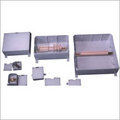Electrical Outlet Boxes
Product Details:
Electrical Outlet Boxes Price And Quantity
- 500 INR
- 450.00 - 500.00 INR
- 1 Piece
Product Description
An electrical outlet boxes is a container for electrical connections, usually intended to conceal them from sight and deter tampering. A small metal or plastic junction box , electrical outlet boxesmay form part of an electrical conduit wiring system in a building, or may be buried in the plaster of a wall, concealed behind an access panel or cast into concrete with only the lid showing. It sometimes includes terminals for joining wires. A similar container used for joining wires to electrical switches or sockets is called a pattress.
The term may also be used for a larger item such as a piece of street furniture. In the UK, this is sometimes called a cabinet. See Enclosure (electrical).
Electrical outlet boxes form an integral part of a circuit protection system where circuit integrity has to be provided, as for emergency lighting or emergency power lines, or the wiring between a nuclear reactor and a control room. In such an installation, the fireproofing around the incoming or outgoing cables must also be extended to cover the electrical outlet boxes to prevent short circuits inside the box during an accidental fire.
Product details
|
Apparatus Standard |
Standard |
|
Size |
All |
|
Material |
FRP |
|
Brand |
Electromac |
|
Color |
All |
|
Features |
weatherproof |
Versatile Mounting and Robust Construction
Choose from wall mounted, surface mounted, or flush mounted options to fit a variety of installation needs. Crafted using punch & die formed or spot welded galvanized/mild steel as per IS 513 and IEC standards, these outlet boxes guarantee a sturdy, rust-resistant structure. Their compatibility with standard wiring systems, coupled with tolerance of 0.1 mm, supports precise and efficient electrical projects.
Certified Safety and Reliability
Safety matters. Our electrical outlet boxes conform to IS 8623 for fire resistance and feature ingress protection ratings from IP30 to IP44, safeguarding electrical installations from dust and splashes. The inclusion of plastic end caps enhances end protection, reducing accidental contacts. Suitable for universal brand compatibility, these boxes are a trusted choice for distributors, exporters, manufacturers, and service providers.
FAQs of electrical outlet boxes:
Q: How do I select the appropriate mounting option for these electrical outlet boxes?
A: You can choose between wall mounted, surface mounted, and flush mounted installation based on your specific application. Wall mounting is ideal for exposed areas, surface mounting suits quick installations, while flush mounting provides a seamless look by embedding the box within the wall.Q: What benefits does the rust-resistant feature offer?
A: Rust resistance ensures longevity and performance, especially in humid or challenging environments. The galvanized or powder-coated finish helps prevent corrosion, maintaining a secure enclosure for electrical wiring over years of use.Q: When should I use outlet boxes with higher ingress protection ratings?
A: If your installation is prone to dust or occasional splashing from water (such as in kitchens or semi-outdoor spaces), opt for boxes rated closer to IP44. Lower IP ratings, like IP30, are suitable for dry, dust-protected indoor environments.Q: Where are these electrical outlet boxes commonly installed?
A: These boxes are widely used in residential, commercial, and industrial properties across India. They can be installed in walls, ceilings, or pillars, facilitating safe and organized electrical wiring at building sites, offices, and factories.Q: What is the process for installing these outlet boxes?
A: Installation is simplified by the screw or slot fitment mechanism. After deciding the mounting type and position, attach the box using appropriate fasteners. Plastic end caps are provided to cover any exposed wire ends, and the products tolerance supports easy alignment during fitment.Q: How does this product ensure compatibility with different brands or standards?
A: These outlet boxes are designed for universal compatibility, produced according to IS and IEC standards. Their sizes, shapes, and connection methods suit wiring devices and accessories from multiple manufacturers, enhancing versatility for electricians and contractors.
Price:
- 50
- 100
- 200
- 250
- 500
- 1000+


 English
English Spanish
Spanish French
French German
German Italian
Italian Chinese (Simplified)
Chinese (Simplified) Japanese
Japanese Korean
Korean Arabic
Arabic Portuguese
Portuguese





 Contact Us
Contact Us Send Inquiry
Send Inquiry Send SMS
Send SMS
